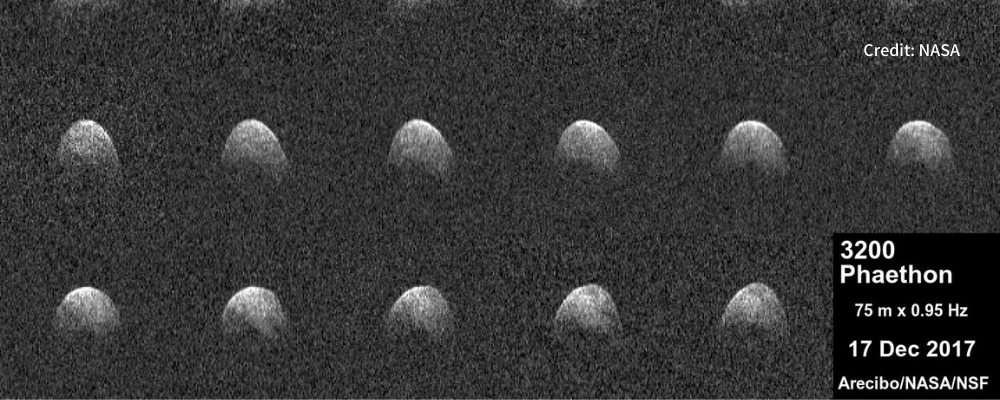Planetary Defense プラネタリーディフェンス というのはあまり聞きなれない言葉ですが、直訳すると 惑星防衛 という意味です。
宇宙空間には小惑星や岩石が漂っていますが、その中でも地球に衝突する可能性のあるものを発見し、何らかの対策を講じることを言うようです。
その惑星防衛について知っておくべき 10 のことと題して NASA の Jet Propulsion Laboratory (JPL) ジェット推進研究所 が解説記事を出しています。
10 Things You Should Know About Planetary Defense
ここではその 3 番目と 4 番目の話題について英文記事を読み解いていきながら、その内容を見ていきたいと思います。
Contents
惑星防衛について知っておくべき 10 のこと #3 & #4
#3.小惑星が衝突する頻度
実は、毎日 100 トンもの星間物質が地球に降り注いでいて、そのほとんどは小さなダスト/微粒子の形状なのだそうです。
3. Frequency of Impacts
Every day, roughly 100 tons of interplanetary space material rain down on our planet, most of it in the form of tiny dust particles. Small planetary debris the size of grains of sand, pebbles and rocks also rain down daily into Earth’s atmosphere, producing the meteors – commonly called “shooting” or “falling stars” – that you can see on any dark clear night. Occasionally, Earth passes through denser streams of small debris released from comets – that’s how we get meteor showers. Sometimes larger, chair-sized or even car-sized space objects enter Earth’s atmosphere and create really bright meteors, called fireballs or bolides, which disintegrate as they explode in the atmosphere. Very rarely, every few decades or so, even larger objects enter the atmosphere, such as the house-sized object that streaked across the sky over Chelyabinsk, Russia, in 2013, producing a super-bright fireball and a shock wave that blasted out windows and broke down doors.
10 Things You Should Know About Planetary Defense より引用
大きさ的に砂粒や小石や岩くらいのサイズの小さな星のがれきも日常的に地球大気内に降り注いでいて、暗く晴れた夜には流れ星として見られる隕石となります。
たまに、彗星から放出された小さながれきの多く集まるあたりを地球が通過することがあり、流星群として観測されますね。
時にはより大きな、イスや車ほどのサイズの物体が地球の大気圏に入ってくることもあり、火球と呼ばれる非常に明るい隕石となります。
この火球は大気中で爆発しながら分解されていきます。
非常に稀ですが、数十年に一度程度はさらに大きな物体が大気圏に進入してくることがあります。
例えば 2013 年にロシアのチェリャビンスク州の上空を通過したのは家ほどの大きさの物体で、非常に明るい火球を作り出し、その衝撃波で窓が吹き飛ばされドアが破壊されたほどでした。
rain down は文字通り 雨のように降り注ぐ という意味です。
#4.観測された小惑星についてのデータの管理
観測された小惑星についてのデータは、the Minor Planet Center (MPC) 小惑星センター という機関で管理されているのだそうです。
4.World Asteroid Data Repository
The Minor Planet Center has a modest name, but this office has a major job. Located in Cambridge, Massachusetts, and operating out of the Smithsonian Astrophysical Observatory, the Minor Planet Center (MPC) is the world’s repository of all observations and computed orbits of asteroids and comets in the solar system, including all the near-Earth object (NEO) data. An NEO includes any asteroid, meteoroid or comet orbiting the Sun within 18,600,000 miles (30 million kilometers) of Earth’s orbit. Any time an astronomer observes an NEO using a telescope on the ground or in space, they send their measurements of the object’s position to the Minor Planet Center. The MPC’s complete set of observations of an object from observatories around the world can be used to calculate the most accurate possible orbit around the Sun for the object to see if it could pose a risk of impact on Earth.
10 Things You Should Know About Planetary Defense より引用
MPC の所在地はアメリカ・マサチューセッツ州のケンブリッジで、the Smithsonian Astrophysical Observatory スミソニアン天体物理観測所 が運営しています。
そしてこの MPC には世界中の全観測データが保管されており、すべての the near-Earth object (NEO) 地球近傍天体 を含む、太陽系における小惑星や彗星の軌道を計算しているのだそうです。
NEO 地球近傍天体 に分類される天体には、地球の軌道の 1,860 万マイル(3,000 万キロメートル)以内にあるすべての小惑星、流星物質、彗星、が含まれます。
天文学者が NEO を観測した際にはいつでも、観測したその天体の位置情報を MPC に送ります。
世界中から集めた観測データから成る MPC の観測データセットによって、太陽を周回する軌道を正確に計算して予測し、地球に衝突するリスクがあるかどうかを確認するのです。
modest は 地味な・控え目な という意味です。
まとめ
地球周辺を漂う小惑星などの観測データが世界中から集められ、そのデータをもとに正確な軌道を予測し、地球に衝突する可能性を計算していたのですね。
聞きなれない専門用語はいくつかありますが、英文としても素直な文章で読みやすかったのではないかと思います。
こういう読解を続けて行くと英文に慣れてきて内容も理解しやすくなってきますね!


